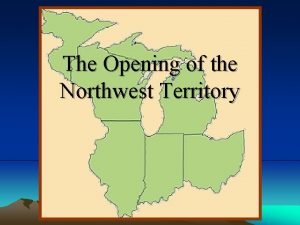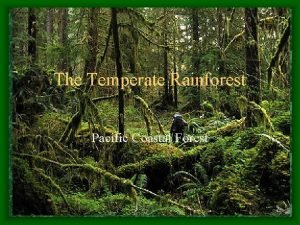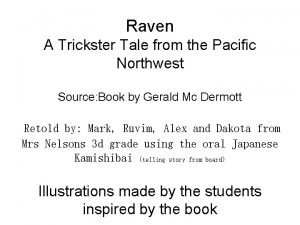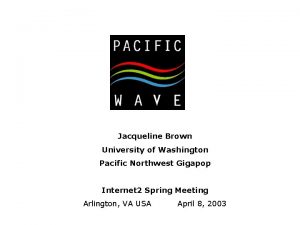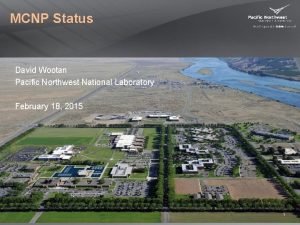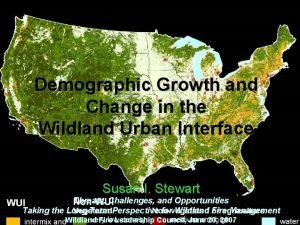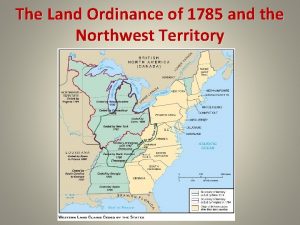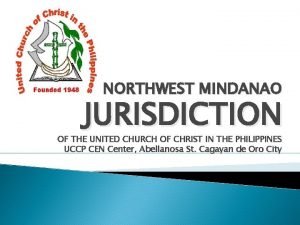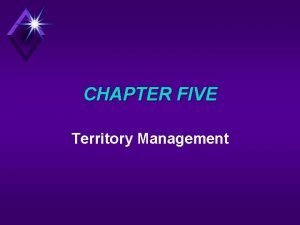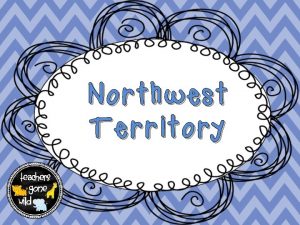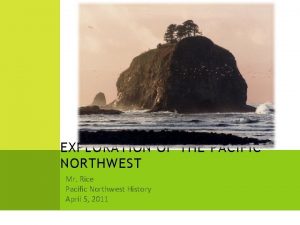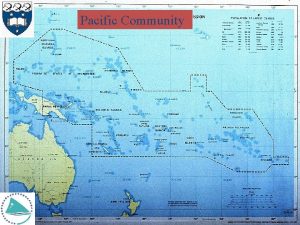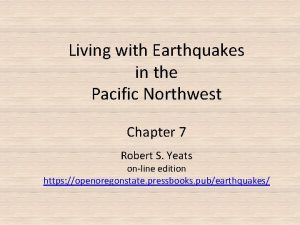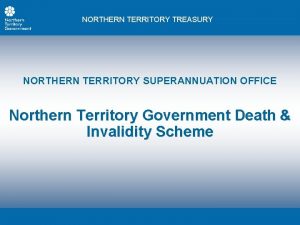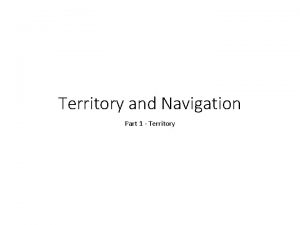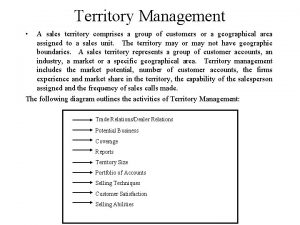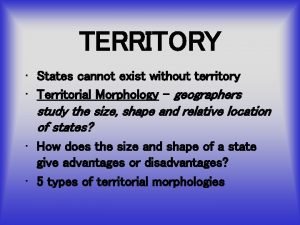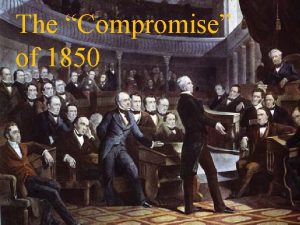Living in Washington Territory Pacific Northwest History Mr


























- Slides: 26

Living in Washington Territory Pacific Northwest History Mr. Rice April 28 , 2011

Things to Keep in Mind… • Manifest Destiny • John L O’Sullivan • Reasons for going west: • Social Mobility • Abolitionism • Financial Gain • The Donation Land Claim Act of 1850: • Gave 320 Acres to white males and doubled that if you had a wife. • Congress creates the Washington Territory in 1853

Living in the Territories • There was nothing easy about living in territorial Washington • Along with the danger of animals and diseases there was also the persistent threat of natives. • This was made possible by advancements in technologies such as – • The John Deer Plow • Covered Wagons • Advancements in hunting and rifling • Continental Railroad • The mechanical reaper

Map of Washington Territory

Plotting the West • Property lines and Boundaries were split by doing the following – • First, the land was surveyed and broken into townships, sections consisting of 640 acres, and each section was divided into quarters. • Corners would be marked by settlers (Homesteaders) or by marking a “Witness Tree” • A witness tree was the nearest tree to a corner.


Newspapers in the west The majority of newspapers in the west got their start and found their success in publishing rights of homesteaders to property that they had claimed. You had to do this to advertise to all others that you were claiming the land so that if someone else had claimed the same plot then they could challenge your claim.

What was it like? • Disease • Doctors did not know how diseases spread so they would send many to the west to take in the fresh air and open spaces. • Food • It was all scarce and meat and basic baking goods were at a premium. • Fun and Games • Mail Service • The services were far and in between at best.

Settler-Indian Conflict • Following the Murders of the Whitmans (early Christian settlers) in 1847, conflict between settlers and Indians occurred for three decades. • This was the Cayuse War. • After the Cayuse War the native groups of WA were put on early reservations. • Because of this, by the 1880 s the majority of natives lost their lands and their traditional way of life.

Map of Early Indian Reservations

Free Response #6 April 29, 2011 • Must be a minimum of 3 -5 sentences. • Explain the idea of Manifest Destiny and why it was important to people in the mid 19 th century. What did people hope to accomplish? What did the U. S. Government hope to accomplish?

Governor Stevens’ Plan • Under the Stevens Plan, the Governor and Secretary of Indian Affairs wanted to – • Make treaties with the tribes of WA • Pay them for their lands and • Teach the natives to farm. • Stevens held council treaty meetings with the natives throughout WA Territory to negotiate terms. • These treaties establishedmost Indians would have to sell their land then the US government would set aside land for the natives.

Indian Reservations circa 1885

Indian Reservations today

The Yakama War I • A few years after the treaties were signed, gold was found on the upper Columbia. • This brought gold seekers that trespassed through Yakama lands that had been given by Gov. Stevens. • Stevens prohibited whites from entering Yakama Land, but they came anyway. • Chief Kamiakin and the Yakamas sought revenge and started killing white intruders. • At the same time, the young village of Seattle was attacked by neighboring tribes.

The Yakama War II • Soldiers were sent out from Fort Walla to take care of the situation, but they were quickly turned back. • Eventually, the army sent out 600 soldiers to punish the native. • They captured and slaughtered 700 native horses and hung 24 of the Indian leaders. • Soon after, the army forced the native tribes to sign embarrassing peace treaties which ended the Yakama War.

Reasons for Indian-White Conflict • Food – Differences between hunting and gathering v. cultivation and farming. • Land Ownership – Natives had no individual land rights amongst themselves. However, white settler wanted to own and change the land. • Language – A heavy language barrier between the two groups. • Leadership – Settlers spoke to national leaders, while native always had to have the approval of the tribal council. • Concept of Superiority – “The Civilized way” was prevalent among settlers.

Conflict with Natives in Summation • Because of the fact that the natives had lived on the land for thousands of years in a semi-nomadic style, when permanent settlers came west, it inherently created conflict between the two races, both socially and culturally. Eventually, because of superior firepower and technology, the white Americans would wage a war of attrition and fear that would place all native peoples on ever dwindling reservations, usually in the worst land with the fewest natural resources.

MODERNITY HITS THE WEST

New Towns arise • Several things contributed to the growth of cities around Puget Sound and in eastern Washington: • Natural Resources – natural harbors, rivers, trees, fish, farmland, gold and coal, and a mild climate • Human Elements – Hard working people, buildings, roads, railroads, ships and advertisements. • Cities that are coming of age at this time include Walla, Seattle and Olympia.

Early Industry in WA Territory • Lumber, Timber, Logging…whatever you want to call it, it was big! • Fishing – Salmon runs in the 1880’s contained millions and millions of fish and because of this canning fish was big business. • Whaling – A traditional way of life for some Coastal native groups, it was big business because of an east coast demand for whale oil to light homes. Also, the whales baleen was used for an assortment of products.

New People in a New Land • Hawaiians – Originally came to work for the Hudson’s Bay Company and end up staying and blending in with the native cultures. • The Irish – Come out west to work in the mines, primarily in Eastern Washington, northern Idaho and Western Montana. • Chinese – By 1870 there were twice as many Chinese miners in WA as white miners. They did menial labor such as washing clothes and cooking and had seriously restricted rights. Life was generally miserable.

Divergence of Immigrant life in WA

The 1880 s - Fishing’s heyday!

TIMBER!!!!!

The Whaling Industry
 Securing the northwest territory
Securing the northwest territory Northwest territory
Northwest territory Pacific temperate rainforest map
Pacific temperate rainforest map Serial killers pacific northwest
Serial killers pacific northwest Raven a trickster tale from the pacific northwest
Raven a trickster tale from the pacific northwest Pacific northwest gigapop
Pacific northwest gigapop Pacific northwest food
Pacific northwest food Www.ctesers.org
Www.ctesers.org Prenhd
Prenhd Pacific northwest smart grid demonstration project
Pacific northwest smart grid demonstration project Pacific northwest research station
Pacific northwest research station Venn diagram living and nonliving things
Venn diagram living and nonliving things Shell living or nonliving
Shell living or nonliving Living non living dead
Living non living dead The smallest living unit within the human body is
The smallest living unit within the human body is A plane flies northwest out of o'hare
A plane flies northwest out of o'hare What is the significance of the northwest ordinance? *
What is the significance of the northwest ordinance? * Low power objective lens
Low power objective lens Land ordinance of 1785
Land ordinance of 1785 Northwest african countries
Northwest african countries Northwest mindanao
Northwest mindanao Nisdtx course guide
Nisdtx course guide Northwest isd ranking
Northwest isd ranking Navfac nw
Navfac nw Krieger eye institute quarry lake
Krieger eye institute quarry lake Northwest isd jobs
Northwest isd jobs Northwest pbis
Northwest pbis

